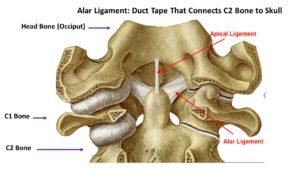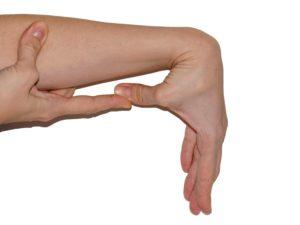The headaches and dizziness are getting worse. Traditional tests failed to identify the problem. Your doctor thinks you may have injured the ligaments in your upper neck. What is the Alar Ligament? What is Cranial Cervical Instability (CCI)? What are the symptoms of Cranial Cervical Instability? How do you fix Cranial Cervical Instability? What is the PICL procedure? Meet JC. Let’s dig in.
What Is the Alar Ligament?
Ligaments are thick bands of connective tissue that connect one bone to another. The Alar ligament connects the upper neck to your head. Specifically, it connects the second building block in the neck (C2) with the skull (occiput) There is a right and a left Alar ligament which is illustrated to the right. The Alar ligament plays a critical role as it provides stability for your head and neck.
What Is Cranial Cervical Instability (CCI)?

Ehler-Danlos Syndrome (EDS): Hypermobile Joints
Cranial Cervical Instability (CCI) is a medical condition where the strong ligaments that hold your head to your upper neck are loose or lax (1). The major ligaments involved are the Alar, Transverse and Accessory ligaments. The two most common causes of Cranial Cervical Instability (CCI) are trauma and medical conditions that cause people to have loose or compromised ligaments (2). Motor vehicle accidents, contact sports, and forceful manipulations by chiropractors are the most common examples of trauma leading to CCI. Ehlers Danlos Syndrome (EDS) is a group of inherited disorders that affect your ligaments and connective tissues (2). Symptoms include overly flexible joints that can easily dislocate. CCI is much more common in patients with EDS especially as they age (3).
What Are the Symptoms of Cranial Cervical Instability?
The most common symptoms of Cranial Cervical Instability include:
Headaches

This is not your normal headache caused by your in-laws or excessive consumption of alcohol. This is a debilitating headache that is constant in duration and miserable.
Upper Neck Pain
Pain is typically localized at the base of the skull and aggravated with flexion and rotation. The pain can shoot up into the base of the skull, top of the head or behind the eyes.
Dizziness
Balance disturbances vary in severity and can make a simple walk down the hall almost impossible at times.
Visual Disturbances
Loss of visual acuity, blurred vision, and changes in peripheral vision can be some of the symptoms in patients with CCI (4).

Brain Fog
Patients with CCI can struggle with memory, concentration, and ability to complete tasks. Every day can feel like your brain is stuffed full of cotton.
How Do You Fix Cranial Cervical Instability?
Patients with CCI can have varying degrees of instability. Patients with minor amounts of instability can oftentimes be managed with
- Upper cervical chiropractic care. Look for members of NUCCA (National Upper Cervical Chiropractic Association)
- Physical Therapy
- Bracing

Surgery for CCI: Fusion of head to neck
- Curve restoration. Look for chiropractors that specialize: Chiropractic BioPhysics.
If conservative options fail to provide improvement the next step is x-ray guided injections into the upper cervical ligaments (5) and upper cervical facets. A facet is a small joint on the backside of the spine that when injured can cause significant neck pain, headaches, and restriction in range of motion. If conservative treatment and injections fail many patients are referred to surgery. There are many different types of surgical options all of which include Fusion. Fusion is a surgical procedure where screws and bolts are placed into the spine to stabilize a targeted level. The most common is a Fusion of the head to the cervical spine, typically at the C2 level. The procedure is major surgery with significant risks which include eventual arthritis above and below the Fusion, misplaced screws in nerves of facet joints, and failure of the bones to fuse (non-union).
PICL: Nonsurgical Natural Treatment Option
PICL stands for Percutaneous Injection of Cervical Ligaments. It was developed at the Centeno-Schultz Clinic in 2015 and involves the placement of a patient’s own stem cells into the damaged or loose Alar and Transverse ligaments. The injection is demanding and requires a high level of skill and experience as the needle is advanced through the back of the mouth into the damaged ligaments. This is not a procedure your PCP or orthopedic or neurosurgeon can perform. To learn more about the PICL procedure please click on the video below.

Meet JC

JC is a 45 y/o Canadian rancher, commercial bush pilot, and rodeo enthusiast who suffered for 8-years with headaches, brain fog, heavy head, neck pain, and irritability. His symptoms occurred with riding a horse, airplane vibration, impact, and when his cervical spine came out of alignment. He was very fortunate to have an exceptional physiotherapist who was able to restore his cervical alignment. Unfortunately, the adjustments did hold and he frequently came out of alignment with the return of symptoms. Other therapies which include dry needling and PRP were not effective. His injuries were thought to be due to multiple rodeo traumas. JC’s ability to ranch, fly, or function was severely impacted as a result of his debilitating symptoms.
In February 2020 he underwent the PICL procedure at the Centeno-Schultz Clinic. Four months after the procedure JC is back flying and working the cattle near – complete resolution of his symptoms. His physiotherapist reports marked improvement as the chronically tight, contracted muscles are now relaxed and working with the other muscles in the neck.
To learn more about his improvement after the PICL procedure please listen to JC’s testimonial.
In Conclusion
The Alar ligament is a thick band of connective tissue that connects your neck to your head. It is susceptible to injury and can cause cervical spine instability. Cranial Cervical Instability (CCI) is a medical condition where the strong ligaments that hold your head to your upper neck are loose or lax. Trauma and congenital medical conditions are the most common causes of CCI. The most common symptoms are headaches, upper neck pain, dizziness, visual disturbances, and brain fog. Treatment is dependent upon the degree of instability. The PICL is an effective non-surgical treatment option for CCI that was developed at the Centeno-Schultz Clinic in 2015. It involves the placement of a patient’s own stem cells into the damaged or loose Alar and the Transverse ligament. JC developed CCI after multiple rodeo injuries and was able literally to get back into the plane and saddle after the PICL procedure.
If you or a loved one suffer from brain fog, headaches, and dizziness that has been unresponsive to conservative care you may have Cranio-cervical Instability. Schedule a telemedicine visit with a board-certified, fellowship-trained physician to learn more about Cranial Cervical Instability and what regenerative options are available. Stop the suffering. Act now and get your life back.
1.Offiah CE, Day E. The craniocervical junction: embryology, anatomy, biomechanics and imaging in blunt trauma. Insights Imaging. 2017;8(1):29–47. doi:10.1007/s13244-016-0530-5
2.Sobey G. Ehlers-Danlos syndrome – a commonly misunderstood group of conditions. Clin Med (Lond). 2014;14(4):432-436. doi:10.7861/clinmedicine.14-4-432
3.Castori M, Voermans NC. Neurological manifestations of Ehlers-Danlos syndrome(s): A review. Iran J Neurol. 2014;13(4):190–208.
4.Ischebeck BK, de Vries J, Van der Geest JN, et al. Eye movements in patients with Whiplash Associated Disorders: a systematic review. BMC Musculoskelet Disord. 2016;17(1):441. Published 2016 Oct 21. doi:10.1186/s12891-016-1284-4
5.Centeno CJ1, Elliott J, Elkins WL, Freeman M. Fluoroscopically guided cervical prolotherapy for instability with blinded pre and post radiographic reading. Pain Physician. 2005 Jan;8(1):67-72. https://www.ncbi.nlm.nih.gov/pubmed/16850045

